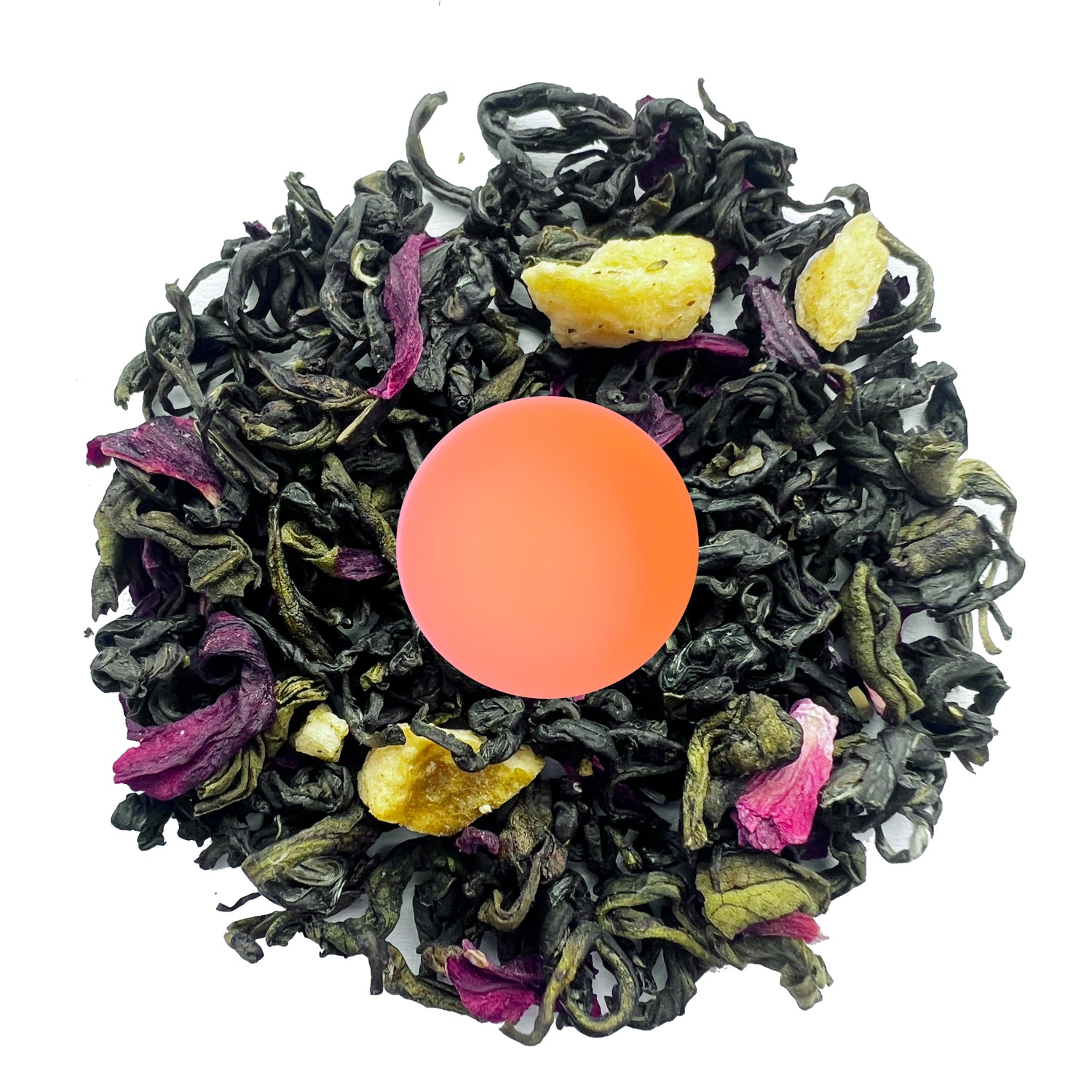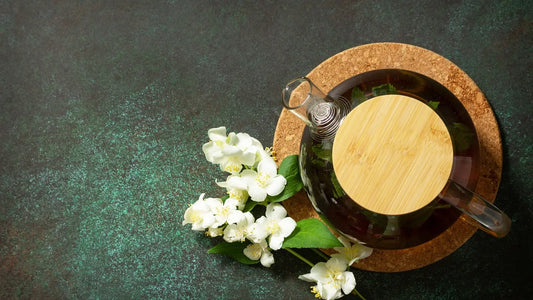Green Teas: Everything You Need to Know

Did you know that a single cup of green tea contains as many antioxidants as 10 servings of fruits and vegetables?
From the ancient tea ceremonies of Japan to the bustling tea markets of China, this emerald elixir has a rich history and a myriad of health benefits.
So, today, let’s dive into the world of green tea and discover why this ancient drink continues to captivate modern society.
What is Green Tea?
Originating from China, Green Teas are made from the leaves of the Camellia Sinensis plant. But, what makes this tea stand out from others is that it is not oxidized or withered at all. This is why the tea's color doesn't change and remains green.
Generally, green tea gives off a lighter and herbaceous taste. But, again, the flavor varies with the types, qualities, and brewing methods.
Some Green teas could taste grassy. While the others might have floral and fruity notes, making it slightly sweet.
Types of Green Tea
Sencha
Sencha is one of the beloved Japanese green teas that offers a fresh and grassy aroma. During the processing time, the leaves are steamed to prevent them from oxidizing and preserve the natural green notes.
Usually, Sencha tastes sweet and savory umami. But, the high-quality could offer rich, seaweed-like, or nutty flavors.
Gyokuro
Gyokuro, grown in the shade, has very dark green tea leaves. It is renowned as the highest-grade green tea in Japan. Gyokuro’s flavor profile is umami-rich, smooth, and sweet.
Gunpowder
Gunpowder (zhu cha) is the oldest green tea that originated from China. Its notable feature is that while processing, the leaves are tightly rolled into little pellets. The tea has a bold and sharp taste with a hint of astringent. You’ll get a smoky and slightly nutty flavor with a sweet aroma.
Longjing Tea
Longjing Tea or Dragon Well is a Chinese special green tea that is harvested in Spring. The teas are processed through a pan-fried technique to prevent the leaves from oxidizing. Longjng tea has a very smooth, sweet, and chestnut-like flavor with a vegetal aftertaste.
Matcha
Matcha is a vibrant green tea powder made from finely grounded young green tea leaves. Commonly prepared for traditional Japanese tea ceremonies, now this drink is enjoyed by everyone worldwide.
Matcha tea has a creamy texture with a smooth and lightly sweet taste. Its flavor profile varies from umami and sweet to slightly bitter. You’ll find three different qualities of matcha such as ceremonial grade, premium grade, and culinary grade.
Genmaicha
Genmaicha, a Japanese green tea, is also popular as popcorn tea. It’s because it contains roasted brown rice which pops and resembles popcorn.
Historically, poorer people drank this brew to make the tea more affordable. However, now Genmaicha is enjoyed by all for its mild, full, toasty, slightly sweet, and a hint of nutty flavor.
Hojicha
Hojicha is a different kind of green tea from Japan, made by roasting leaves or stems over charcoal. So, unlike the other teas, it has a unique reddish-brownish color. Hojicha has a warm, toasty, roasted, and lightly sweet flavor.

Nutritional Information about Green Tea
Green tea is not just rich in flavors. It has a high amount of nutrients too.
If you’re wondering about the nutritional contents, here’s what you can expect in a 1 cup (8-ounce) of unsweetened green tea.
- Caffeine: 29.4 mg
- Calories: 1-2 calories
- Theobromine: 0 mg
- Carbohydrate, by difference: 0 mg
- Sugar: 0 mg
- Iron, Fe: 0.049 mg
- Sodium, Na: 2.45 mg
- Fat: 0 g
- Cholesterol: 0 mg

How to brew green tea?
Green tea is very simple to brew at home and should take around 5-10 minutes. You may follow any one of the given instructions depending on the type of green tea you have.
Green Tea Bag
If you have a green tea bag, you could brew it in the cup itself with just 3 steps.
- Firstly, pour hot water (Around 170 to 180 F temperature) in your cup.
- Steep the green tea bag for 5 minutes (Adjust steep time depending on how strong or light you want)
- Remove the tea bag and enjoy!
Loose-Leaf Green Tea
For those who have loose-leaf green tea, here’s how you prepare it.
You’ll need
- Filtered Water
- 2 teaspoons of loose-leaf green tea
- A Kettle and cup
- Teapot, tea infuser, and strainer
Instructions
- Firstly, put filtered water in the kettle and bring it to a boil.
- Leave the water to rest for 5-7 minutes. This way, you may get an approximate water temperature of 170 to 180 Fahrenheit.
- Put the loose-leaf green tea leaves in your teapot.
- Pour the water into your teapot. Then, cover the pot using a lid to extract more flavors.
- Steep the tea for about 2-3 minutes. (Adjust the time how you want)
- Take a strainer and your cup. Then, use it to pour the tea.
Green Tea Flavors
We introduced you to one of the classic and traditional ways to prepare green tea. But, we encourage you to tweak the flavors and develop new recipes too.
For instance, you could enjoy green milk tea, green tea latte, matcha lemonade, and so on.
Nowadays, Green tea comes blended with extensive flavors, offering you a more unique and sophisticated taste. Some common flavors are:
- Blueberry And Green Tea
- Cinnamon Green Tea
- Green Tea Pomegranate
- Turmeric Powder In Green Tea
- Green Tea Mint
- Lemongrass Green Tea
- Green Tea And Turmeric Tea
- Jasmine Flower Green Tea
- Nepal Jasmine Green Tea
- Ginger and Honey Green Tea
Green Tea Brands
If you want to prepare green tea, you could try out these famous brands that offers high-quality green tea.
- Lipton
- Stash
- Honest Honey
- Tazo
- Danfe Tea
- The Vert
- Citrus Diet
- J-Scent
- Jasmine Pearls
- Mighty Leaf

Green Tea Benefits
Supports Weight Loss
As green tea has a high concentration of catechin-like epigallocatechin gallate, this antioxidant may help support weight loss in obese people. It may also increase metabolism and fat burning while doing exercises.
Reduces Stroke Risk
The American Heart Association has cited that drinking green tea without flavors might help to lower the stroke risk.
May Reduce the Risk of Cancer
According to the study published in the Journal of Nutrition, active polyphenol antioxidants in green tea might help to reduce the risk of certain cancers like breast, prostate, colorectal, etc. The antioxidants work to protect cells from DNA damage. However, there is still no sufficient scientific evidence to support this claim.
Skin Protection
Green tea also contains anti-inflammatory properties that might be used to improve the affected skin areas. As per the research of the National Library of Medicine, green tea extract is also used in cosmetics for anti-inflammatory responses.
Disadvantages of Green Tea
When overconsumed, Green tea can have negative impacts on your health too.
- Since green tea naturally has caffeine, you might experience some side effects.
- Tannins in green tea might worsen anemia.
Drinking green tea in moderation might help reduce these effects.

Green Teas FAQs
Does green tea stain clothes?
Yes, since green tea contains tannins, it could stain your clothes with a yellowish or greenish color.
Does green tea taste good?
As every person's taste and preference is different, it is highly subjective to claim that Green tea tastes good. However, you may find a wide range of green tea flavors such as sweet and nutty, grassy and vegetal, floral and delicate, or bitter and astringent.
Is oolong tea black or green tea?
Oolong tea is neither black nor green tea. It is one of the tea types produced by the Camellia Sinensis plant and has its own distinct flavor profiles, taste, and processing methods.
Do you put milk in green tea?
Usually, the classic green tea is enjoyed by infusing it in water only. Due to the tea's delicate flavor profile, adding milk could overpower the taste, making it bitter and astringent. However, if you want, you may add milk to your green tea.
Does green tea have less caffeine than black tea?
Yes, in comparison to black tea, green tea contains less caffeine. As per the FDA, in an 8-ounce cup, green tea contains 29.4 mg of caffeine whereas black tea has 47.4 mg.
What is the pH of green tea?
The pH level of Green tea varies from 6.5 to 8.0
Is green tea alkaline or acid?
Since green tea's pH level is near neutral, it is more alkaline than acidic.
Does drinking green tea stain your teeth?
Yes, green tea contains tannins and it can stain your teeth. However, the stain effect is less compared to black tea or coffee.
Does green tea with jasmine have caffeine?
Green teas are naturally caffeinated. So, yes green tea with jasmine contains caffeine of about 30-50 mg in an 8-ounce cup.
How to make green tea taste good?
There are various factors you could pay attention to make green tea taste good. Make sure you use fresh and filtered tap water, pick high-quality green tea, set the perfect brewing time and temperature, and add flavors if you want.
Is green tea good for dogs?
While the antioxidants in green tea can be beneficial to humans, they could have a negative impact on dogs. Also, the caffeine presence of green tea might be toxic and trigger symptoms like vomiting, diarrhea, heart palpitations, etc. Regardless, we suggest you consult with your vet doctor before feeding green tea to your dog.
How much green tea do you need per cup?
The serving size depends on the type of green tea you choose and how strong you want. But, in general, 1 tablespoon of loose-leaf tea or 1 tea bag per cup may be enough.
Is honey good in green tea?
Well, normally, green tea is served without any sweeteners or additional flavors. But, if wish to enhance the taste and make the tea sweeter, you may put honey in green tea.

Conclusion
Since Green tea has a sophisticated taste profile, you don’t want to miss out! We encourage you to experience this delightful flavor yourself.
For top-notch quality, we invite you to explore our Danfe Tea’s Nepal loose-leaf green tea, made in the Himalayas. Savor the sweet jasmine and herbaceous flavor of the tea with buttered asparagus aroma. Try it out today and let us know your experience.








